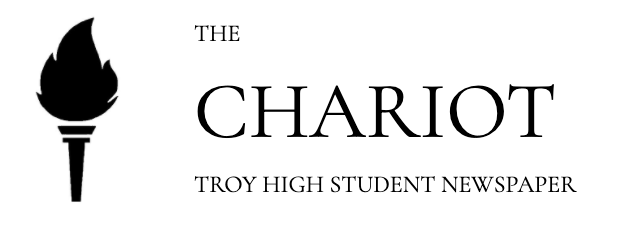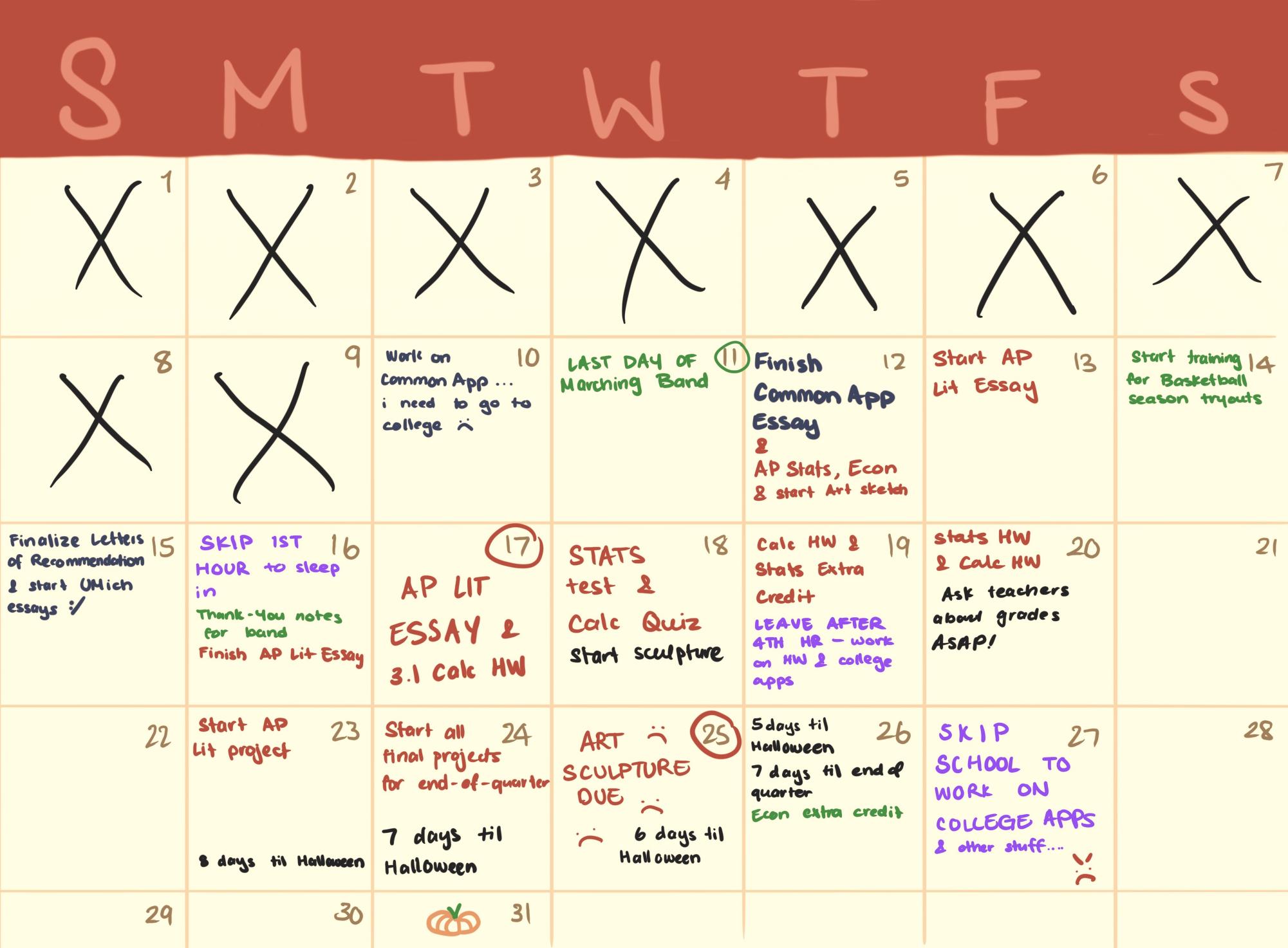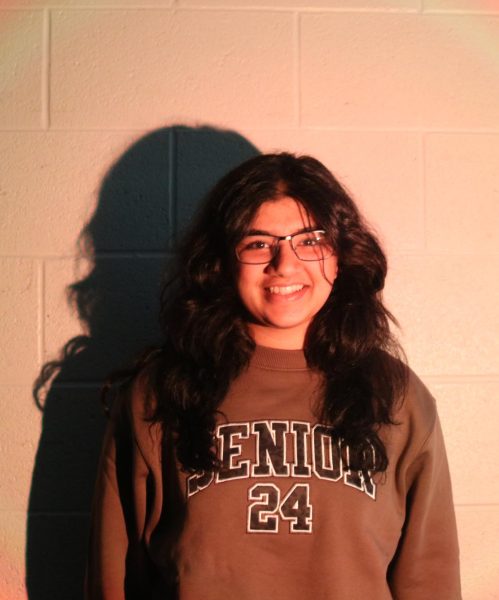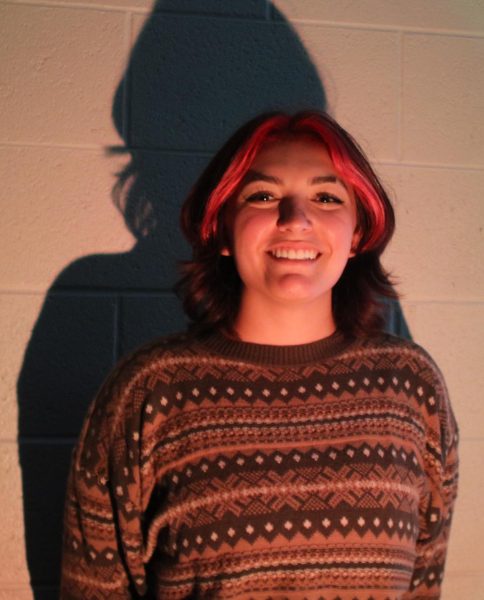In a coffee shop in late October, amid the bustle of the afternoon rush, a student sits at a table all alone. They’ve got loads of homework ahead of them, but they can’t seem to keep their focus. It isn’t the wafting scents of a fresh pumpkin brew. It isn’t the classical jazz on loop in the background. It’s mental exhaustion.
The longest stretch of the school year without a designated break is from Labor Day to Thanksgiving break. Many students have sat in a coffee shop, unfocused, or at home, burdened by the sheer amount of tasks placed on their shoulders. This phenomenon is strongest during the fall. In a survey of 88 Troy High School students conducted by The Chariot, nearly 90% of respondents admitted to feeling a significant amount of mental exhaustion in the past 12 months.
Furthermore, 50% of students named October as the month in which they felt the most overwhelmed. The same survey concluded that 87.5% advocated for the implementation of a fall break at Troy High School, agreeing that this would help alleviate some of this mental exhaustion.
Fall breaks usually occur in the month of October and have been slowly put in place at the university level since the mid to late 1990s. At schools like the University of Michigan and Michigan State University, fall breaks have been part of the calendar year for decades. At others like Central Michigan University, fall breaks have only become more common after COVID-19 and the resulting mental health crisis.

A fall break at Troy High School would theoretically consist of a long weekend during the month of October; a momentary pause during the longest, uninterrupted stretch of the school year. The break promises to ease tensions during a busy time period for all students. Research shows that mental health of students tends to be significantly worse in the months of October and January, with anxiety specifically peaking in the former.
When asked if he’d noticed a similar trend, Ali Ali-Ahmed, a counselor at Troy High School, shared: “The entire month of October is pretty complex. For a lot of our seniors, they are working with the college application process and trying to keep their grades up as much as possible.” The counselor also mentions the PSAT and other CollegeBoard assessments that take place in the beginning of the year. “Kids start to realize [that] junior year is an important year or that the college application process is a class in itself.”
However, the stress of October isn’t entirely limited to the upperclassmen. “You have the ninth graders transitioning from middle school to high school, coming to a much bigger school. Then you have the sophomores, trying to bring their grades up if their ninth grade year wasn’t as good as they wanted it to be.” “We’re just surviving our school year instead of thriving and learning?” — Joseph Verhelle, English teacher
Joseph Verhelle, an English teacher at Troy High School, commented on the stresses shared by freshmen in his classes: “Everything is new to them. You start getting into November and they’re like, ‘I don’t know if I can do this forever or for the next four years of my life,’ so they start getting a little squirrely.” He continues, “I find myself repeating, ‘This is the hardest part of the school year, you just have to make it through this,’ but then I’m like, we’re just surviving our school year instead of thriving and learning?”
English teacher Emily Rusk shares his sentiment. “The new back-to-school honeymoon phase of being excited to be back and ready to be on your game; it fades so fast because you get so tired. They give you that break in college and we should also have that.”
The realization that October has zero days off surprised Ali-Ahmed. “It’s a great checkpoint,” Ali-Ahmed said. “A break or a pause in reality [where students can] utilize that time to study or catch up on missing assignments, projects, tests, quizzes and assessments; to feel overly prepared instead of just prepared.”
Seniors at Troy High School often have “senior skip days” at the end of October to work on college applications instead of attending school. Ali-Ahmed believes that a fall break would negate the need for seniors to miss a day of school and any related assignments. “Having that break within the fall would be nice because it’s more systematic rather than missing assignments,” he said. “If it’s scheduled, teachers can plan ahead to make sure to have that little break that’s necessary.”

He continued, touching on the lack of relaxation provided by these student-planned “senior skip days.” “A part of you did not enjoy your time off because you’re thinking about the assignments you’re missing.” He echoes that a fall break would likely eliminate or greatly reduce the impact of this issue on both seniors and teachers.
The effects of a fall break are not limited to research papers and hypotheticals. Former Troy High School student Caroline Huang is a freshman at Michigan State University, one of the many higher education institutions to become part of the growing trend to implement a fall break. Huang discussed the stress she felt prior to participating in her first fall break as a freshman this year: “I was starting to get a little depressed and overwhelmed before break so it was a nice refresher to meditate and relax.”
Huang spent her fall break with family, recuperating from the wearisome first few weeks of freshman year. “Break was good for my mental health and I think I needed it,” Huang concluded.
At Michigan State University, the gap between the start of the school year and fall break is only four weeks. At Troy High School, the gap between the start of the school year and Thanksgiving break is thirteen weeks.
English teacher Lisa Knudson reiterates the need for a fall break at Troy High School. “It is not only just needed; the stretch from August to Thanksgiving is the hardest stretch of the entire school year. When we hit this point, kids are burned out, teachers are burned out, nobody has patience anymore and everybody just needs a day off.” I just feel like at this point in the year, if your mental capacity is not up to standard, how are you supposed to support your students too? — Emily Rusk, English teacher
Rusk agreed. She expressed that teachers’ poor mental health at this point is only harming their student’s own struggles. “There are so many pressures that we as teachers put on ourselves, especially to support our students in so many ways. I just feel like at this point in the year, if your mental capacity is not up to standard, how are you supposed to support your students too? We’re also struggling. It’s just very hard.”
Knudson added on, acknowledging the importance of rewarding herself with fun things during the year to keep her motivation up. In October, though, she said, “I don’t feel like [rewards are] as warranted during this stretch; like I haven’t earned it.”
Verhelle elaborated on some of the struggles teachers face in the fall. “Compared to the other periods of the school year, I take more naps. I’m less productive. I’m just not in tip-top shape right now compared to in the early spring.”
He then described how prolonged fatigue can have an effect on his students. “I’m a terrible teacher during that time. No one wants to be around me. I don’t want to be around them. It’s just not productive for learning.” Teachers’ mental health during this time period is as much a concern as students’ mental health when advocating for a fall break addition to the calendar.

While there seems to be enough desire for a fall break at Troy High School, the process behind implementing new breaks in the Troy School District Calendar may be more trouble than it’s worth.
Christine DiPilato, the Assistant Superintendent of Secondary Instruction for the Troy School District, explained it as the following: “We have to meet the expectations of the state, we have to meet the expectations of our community and then we want to be good partners in working with our teachers to make sure that they feel supported too. There’s a lot of different parties involved in that work. It’s challenging.”
The state of Michigan currently requires that schools operate at a 180-day minimum with at least 1,098 instructional hours. The district determines the best way to meet state requirements in a series of negotiations with the Troy Education Association, also known as the teachers’ union.
DiPilato dispelled any rumors saying that Troy High School exceeds the state-mandated limit by eight days. “Troy High School does not exceed 180 instructional days.” She continued, explaining that the district’s school year is extended in comparison with other districts because of long weekends at the end of marking periods. Having those days off in the middle of the instructional period adds a week at the end of the school year. “It feels a lot longer.”
When negotiating the district calendar, attendance rates per day play an important role. To be considered a full instructional day, the school must have 75% of its students in attendance. Currently, Troy High School averages at a rate of 96%.

DiPilato acknowledges that mid-to-late October brings its own set of challenges to students. “That’s when a lot of the anxiety starts to ramp up. We see students start to make poor decisions, we see disciplinary issues, we see mental health start to drop a little bit.” She added that teachers may be feeling the same mental exhaustion as students as they adhere to the same calendar. “Teachers are tired, too.”
Currently, the Troy School District is in the negotiation process with the teachers’ union. Alongside working on a new contract, the negotiations will also focus on curating a new calendar for the next contract cycle. The state of Michigan has recently repealed a piece of legislation requiring schools to open after Labor Day. Before its repeal, the Troy School District would submit annual requests to bypass this legislation. This allowed the school year to begin in late August rather than the state-mandated early September. Without this early start, the year would continue even later into the summer.
DiPilato acknowledged the lack of contentment surrounding the extended school year and the issues that this creates: “No one wants to go to school on June 20th. We all want to be done that first or second week of June if we can be.”
This is echoed throughout the district, including by teachers. Knudson expressed her wish for a fall break, but with one condition: “I don’t want to go to school another week in the summer, though. We get out later than anybody.”
This isn’t as simple as it may sound, however. If a break is added in October, the instructional day requirement must be met through other means; by either limiting other scheduled breaks in the year or extending the school year further into the summer.
With a fall break at Troy High School being unlikely, DiPilato questions, “How are we providing that release valve for students when the pressure becomes high?”





